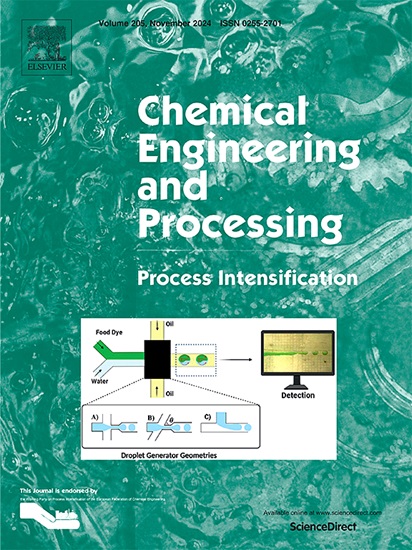铁基氧载体微藻生物质化学环气化产气及其动力学行为
IF 3.8
3区 工程技术
Q3 ENERGY & FUELS
Chemical Engineering and Processing - Process Intensification
Pub Date : 2025-02-10
DOI:10.1016/j.cep.2025.110215
引用次数: 0
摘要
化学循环气化(CLG)是一种高效的能量转换和利用方法。通过氧载体氧化还原将生物能源转化为高价值气体是一项新兴技术。本文通过TG-FTIR-MS测试将普通小球藻(Chlorella vulgaris, CV)与oc的热解过程主要分为三个阶段。以铁矿石为原料,石英砂为空白试验。OCs的加入提高了反应速率,并对焦油裂解有催化作用。第二阶段和第三阶段的动力学方程分别为dα/dt=3.12(1-α)3·exp(-1.62 × 104/T)和dα/dt=5.49[(1-α)2/3/(1-(1-α)1/3)]·exp(-4.86 × 104/T)。最可能的机理函数分别是反应阶模型(O3)和扩散模型(D3)。第二阶段和第三阶段的平均活化能E0和指数前因子A0分别为134.44 kJ/mol和3.12 min-1和404.18 kJ/mol和3.66 min-1。活性炭的CLG过程表明,活性炭的加入提高了CO2、H2和CO的产率。CO产量由0.097 Nm3/kg增加到0.313 Nm3/kg,增幅最大。碳转化率和气化效率分别从41.7%和43.4%提高到78.3%和54.9%。适当提高温度可以促进CV的深度热解气化,生成更多高值热解气。微藻CLG发电系统通过LAC对环境的负面影响较小,是一种有价值的气化技术。本文章由计算机程序翻译,如有差异,请以英文原文为准。

Chemical looping gasification of microalgae biomass with Fe-based oxygen carrier for gas production and kinetic behavior
Chemical looping gasification (CLG) is an efficient method for energy conversion and utilization. It is an emerging technology to convert bioenergy into high value gas through redox of oxygen carriers (OCs). In this paper, the pyrolysis process of Chlorella vulgaris(CV) with OCs was mainly divided into three stages by TG-FTIR-MS test. Using iron ore as OCs and quartz sand as blank experiment. The addition of OCs increases the reaction rate and exhibits a catalytic effect on tar cracking. The kinetic equations for Stage 2 and Stage 3 are dα/dt=3.12(1-α)3·exp(-1.62 × 104/T) and dα/dt=5.49[(1-α)2/3/(1-(1-α)1/3)]·exp(-4.86 × 104/T), respectively. The most probable mechanism functions are the reaction order models (O3) and the diffusion models (D3), respectively. The average activation energy E0 and pre-exponential factor A0 were 134.44 kJ/mol, 3.12 min-1 and 404.18 kJ/mol, 3.66 min-1 for Stage 2 and Stage 3, respectively. The CLG process of CV&OCs showed that the yields of CO2, H2 and CO were increase by the addition of OCs. The CO yield increased most significantly from 0.097 Nm3/kg to 0.313 Nm3/kg. The carbon conversion and gasification efficiency increased from 41.7 % and 43.4 % to 78.3 % and 54.9 %, respectively. Moreover, appropriately increasing the temperature can promote the deep pyrolysis gasification of CV and generate more pyrolysis gas with high value. The microalgae CLG power generation system was found to have less negative effects on the environment through LAC and is a worthwhile gasification technology.
求助全文
通过发布文献求助,成功后即可免费获取论文全文。
去求助
来源期刊
CiteScore
7.80
自引率
9.30%
发文量
408
审稿时长
49 days
期刊介绍:
Chemical Engineering and Processing: Process Intensification is intended for practicing researchers in industry and academia, working in the field of Process Engineering and related to the subject of Process Intensification.Articles published in the Journal demonstrate how novel discoveries, developments and theories in the field of Process Engineering and in particular Process Intensification may be used for analysis and design of innovative equipment and processing methods with substantially improved sustainability, efficiency and environmental performance.

 求助内容:
求助内容: 应助结果提醒方式:
应助结果提醒方式:


